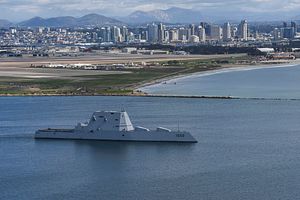The first-of-class USS Zumwalt (DDG1000), a 16,000-ton next generation guided-missile destroyer, has embarked on its first “operational period at sea,” the U.S. Navy said in a recent statement. The warship departed Naval Base San Diego in California on March 8.
During its at-sea deployment, the Zumwalt will travel up the American West Coast and visit a naval base in Canada later this month, USNI News reported last week.
The USS Zumwalt was commissioned in October 2016. Following the commissioning, the Zumwalt was transferred to San Diego where its weapons systems were installed and activated. According to the Navy, the ship’s crew just completed a post-delivery maintenance availability designed to thoroughly evaluate the destroyer’s systems and equipment to include radars and engineering plant.
The installation and activation work of the Zumwalt’s combat systems was overseen by U.S. defense contractor Raytheon.
Zumwalt-class destroyers feature distinct wave-piercing tumblehome hulls and a stealth design meant to reduce the ship’s radar cross-section.
“Zumwalt is designed for stealth,” said the ship’s commanding officer, Captain Andrew Carlson. “This aids her role as a multi-mission surface combatant and improves the fleet commander’s options for delivery of naval combat power to meet the Navy’s emergent mission requirements.”
The ship headed out for open waters in the morning of March 8.
“My crew has been looking forward to continued testing and operations at sea, leveraging the newly installed capabilities of this platform,” Carlson added. “Our primary focus is executing a safe underway, while building both competence and confidence in operating Zumwalt across the spectrum of naval warfare.”
The Zumwalt, about 100 feet longer and 13 feet wider than the Arleigh Burke class of guided missile destroyers, is powered by two Rolls-Royce main turbine generators and two Rolls-Royce auxiliary turbine generators. The ship can reach top speeds of up to 33.5 knots (38.6 mph).
As I noted repeatedly in the past, while the ship is armed for a wide array of surface, submarine, and aviation missions, it still lacks the proper ammunition for its main guns:
Zumwalt-class destroyers are equipped with 80 MK57 vertical launch tubes, each capable of accommodating one to four SM-1, SM-2, and SM-6, or Tomahawk land-attack missiles. The stealth destroyers will also be armed with new long-range anti-ship missiles such as the Maritime Strike Tomahawk following a change of the mission requirements of the Zumwalt-class from a land-attack platform to surface warfare in November 2017.
The Zumwalt-class still lacks a projectile for its two main guns, with the Navy expected to select a replacement in the coming months.
To date, no projectile has been officially selected.
The Navy’s latest Zumwalt-class destroyer, the USS Michael Monsoor (DDG 1001), was commissioned in January. The future USS Lyndon B. Johnson (DDG 1002), the third and final ship of the Zumwalt class was launched at the General Dynamics Bath Iron Works (BIW) shipyard in Maine on December 2018.
































